Roman Pine, Stone Pine
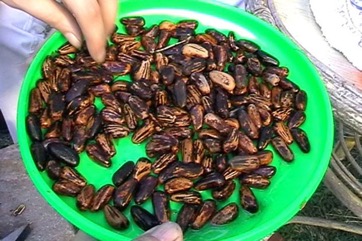
It is a warm temperate plant. It grows naturally on sandy soils near the coast in Mediterranean regions. It grows well in coastal areas. It can tolerate drought once established. It can grow in arid places. It suits hardiness zones 8-10. Arboretum Tasmania. Hobart Domain and Government House, Launceston City Park, Westbury oval.
Also known as:
Cam fistigi, Fistik cami, Italian stone pine, Parasol Pine, Pignoli, Pignolia, Pin, Pina, Pinie, Pinj, Pino, Pinocchi, Pinon mediterraneo, Pinonero, Sanaubar thamari, Umbrella Pine
Synonyms
- Pinus esculenta Opiz
- Pinus fastuosa Salisb.
- Pinus maderiensis Ten.
- Pinus sativa Garsault
Edible Portion
- Seeds, Flavouring, Spice, Shoots - drink
Where does Roman Pine grow?
Found in: Africa, Albania, Australia, Britain, Canada, Croatia, Cyprus, Europe, France, Gibraltar, Greece, Hawaii, Iraq, Israel, Italy, Lebanon, Mediterranean, Mexico, Middle East, North Africa, North America, Portugal, South Africa, Southern Africa, Spain, Syria, Tasmania, Tunisia, Turkey, United States, Yugoslavia
Notes: Biblical references Hosea 14:8. There are over 100 species of Pinus.
Growing Roman Pine, Stone Pine
Cultivation: Plants grow readily from seed.
Edible Uses: The seeds can be eaten raw, roasted or steamed. They are used in sweetmeats, cakes, puddings, stuffings and sauces. They can be mixed in cakes and used for nut milk. The nuts are the source of oil. The young shoots are used to make a drink.
Production: Seeds need warm summers to ripen. Seeds are stored in their cones until ready to be eaten or they become rancid. The seed take 3 years to ripen. The trees take 15 years until they beging to bear and 50 years until they reach maximum production.
Nutrition Info
per 100g edible portion| Edible Part | Energy (kcal) | Protein (g) | Iron (mg) | Vitamin A (ug) | Vitamin c (mg) | Zinc (mg) | % Water |
|---|---|---|---|---|---|---|---|
| Nuts | 567 | 24 | 9.2 | 3 | 1.9 | 4.3 | 6.7 |
Roman Pine, Stone Pine Photos

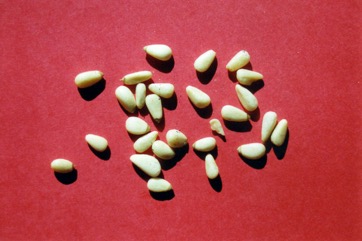
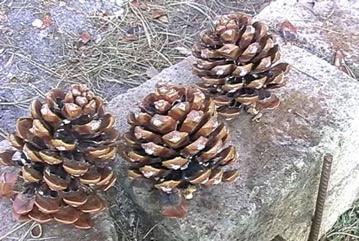
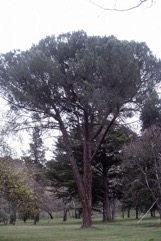
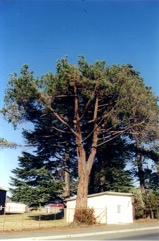
References
Bianchini, F., Corbetta, F., and Pistoia, M., 1975, Fruits of the Earth. Cassell. p 188
Blamey, M and Grey-Wilson, C., 2005, Wild flowers of the Mediterranean. A & C Black London. p 27
Blanco-Salas, J., et al, 2019, Wild Plants Potentially Used in Human Food in the Protected Area “Sierra Grande de Hornachos” of Extremadura (Spain). Sustainability 2019, 11, 456
Bodkin, F., 1991, Encyclopedia Botanica. Cornstalk publishing, p 802
Bonet, M. A. & Valles, J., 2002, Use of non-crop food vascular plants in Montseny biosphere reserve (Catalonia, Iberian Peninsula). International Journal of Food Sciences and Nutrition (2002) 53, 225–248
Bremness, L., 1994, Herbs. Collins Eyewitness Handbooks. Harper Collins. p 73
Brickell, C. (Ed.), 1999, The Royal Horticultural Society A-Z Encyclopedia of Garden Plants. Convent Garden Books. p 802
Cheifetz, A., (ed), 1999, 500 popular vegetables, herbs, fruits and nuts for Australian Gardeners. Random House p 219
Ciesla, W.M., 1998, Non-wood forest products from conifers. Non-wood forest products 12, FAO, Rome, p 72
Coombes, A.J., 2000, Trees. Dorling Kindersley Handbooks. p 72
Cundall, P., (ed.), 2004, Gardening Australia: flora: the gardener's bible. ABC Books. p 1050
Dogan, Y., et al, 2004, The Use of Wild Edible Plants in Western and Central Anatolia (Turkey). Economic Botany 58(4) pp. 684-690
Dolina, K. & Luczaj, L., 2014, Wild food plants used on the Dubrovnik coast (south-eastern Croatia) Acta Soc Bot Pol 83(3):175–181
Ertug, F., 2004, Wild Edible Plants of the Bodrum Area. (Mugla, Turkey). Turk. J. Bot. 28 (2004): 161-174
Ertug, F, Yenen Bitkiler. Resimli Türkiye Florası -I- Flora of Turkey - Ethnobotany supplement
Facciola, S., 1998, Cornucopia 2: a Source Book of Edible Plants. Kampong Publications, p 170
FAO, 1995, Edible Nuts. Non Wood Forest Products 5.
Flowerdew, B., 2000, Complete Fruit Book. Kyle Cathie Ltd., London. p 187
Glowinski, L., 1999, The Complete Book of Fruit Growing in Australia. Lothian. p 135
Gouldstone, S., 1978, Australian and New Zealand Guide to food bearing plants. Books for Pleasure. p 55
Hall, N. et al, 1972, The Use of Trees and Shrubs in the Dry Country of Australia, AGPS, Canberra. p 398
Harris, E & J., 1983, Field Guide to the Trees and Shrubs of Britain. Reader's Digest. p 251
Hedrick, U.P., 1919, (Ed.), Sturtevant's edible plants of the world. p 498
Hussey, B.M.J., Keighery, G.J., Cousens, R.D., Dodd, J., Lloyd, S.G., 1997, Western Weeds. A guide to the weeds of Western Australia. Plant Protection Society of Western Australia. p 14
Jardin, C., 1970, List of Foods Used In Africa, FAO Nutrition Information Document Series No 2.p 46
Kayabasi, N. P., et al, 2018, Wild edible plants and their traditional use in the human nutrition in Manyas (Turkey). Indian Journal of Traditional Knowledge. Vol. 17(2), April 2018, pp 299-306
Kermath, B. M., et al, 2014, Food Plants in the Americas: A survey of the domesticated, cultivated and wild plants used for Human food in North, Central and South America and the Caribbean. On line draft. p 662
Kiple, K.F. & Ornelas, K.C., (eds), 2000, The Cambridge World History of Food. CUP p 433, 1834
Lentini, F. and Venza, F., 2007, Wild food plants of popular use in Sicily. J Ethnobiol Ethnomedicine. 3: 15
Lord, E.E., & Willis, J.H., 1999, Shrubs and Trees for Australian gardens. Lothian. p 87
Menninger, E.A., 1977, Edible Nuts of the World. Horticultural Books. Florida p 153, 155
Mulherin, J., 1994, Spices and natural flavourings. Tiger Books, London. p 109
Paczkowska, G. & Chapman, A.R., 2000, The Western Australian Flora. A Descriptive Calatogue. Western Australian Herbarium. p 28
Phillips, R. & Rix, M., 2002, The Botanical Garden Vol. 1. Trees and Shrubs. MacMillan. p 50
Plants for a Future database, The Field, Penpol, Lostwithiel, Cornwall, PL22 0NG, UK. http://www.scs.leeds.ac.uk/pfaf/
Recher, P, 2001, Fruit Spirit Botanical Gardens Plant Index. www.nrg.com.au/~recher/ seedlist.html p 3
Rivera, D. et al, 2006, Gathered Mediterranean Food Plants - Ethnobotanical Investigations and Historical Development, in Heinrich M, Müller WE, Galli C (eds): Local Mediterranean Food Plants and Nutraceuticals. Forum Nutr. Basel, Karger, 2006, vol 59, pp 18–74
Royal Botanic Gardens, Kew (1999). Survey of Economic Plants for Arid and Semi-Arid Lands (SEPASAL) database. Published on the Internet; http://www.rbgkew.org.uk/ceb/sepasal/internet [Accessed 6th May 2011]
Ruiters-Welcome, A. K., 2019, Food plants of southern Africa. Ph.D. thesis. Univ. of Johannesburg p 87
Ryan, S., 2008, Dicksonia. Rare Plants Manual. Hyland House. p 69
Schuler, S., (Ed.), 1977, Simon & Schuster's Guide to Trees. Simon & Schuster. No. 34
Sfikas, G., 1984, Trees and shrubs of Greece. Efstathiadis Group. Athens. p 40
Segura, S., et al, 2018, The edible fruit species in Mexico. Genet Resour Crop Evol (2018) 65:1767–1793
Solomon, C., 2001, Encyclopedia of Asian Food. New Holland. p 281
Sp. pl. 2:1000. 1753
Staples, G.W. and Herbst, D.R., 2005, A tropical Garden Flora. Bishop Museum Press, Honolulu, Hawaii. p 70
Tardio, J., et al, Ethnobotanical review of wild edible plants in Spain. Botanical J. Linnean Soc. 152 (2006), 27-71
van Wyk, B, van Wyk, P, and van Wyk B., 2000, Photographic guide to Trees of Southern Africa. Briza. p 236
van Wyk, B., 2005, Food Plants of the World. An illustrated guide. Timber press. p 297
van Wyk, Be, & Gericke, N., 2007, People's plants. A Guide to Useful Plants of Southern Africa. Briza. p 22
Wickens, G.E., 1995, Edible Nuts. FAO Non-wood forest products. FAO, Rome. p 51, 178
World Checklist of Useful Plant Species 2020. Royal Botanic Gardens, Kew